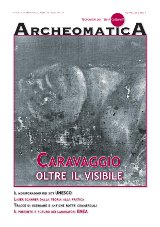LE OSSIDIANE DI PALMAROLA I MARKER DI PROVENIENZA
DOI:
https://doi.org/10.48258/arc.v2i3.84Parole chiave:
Ossidiana, Lazio, SEM-EDS, XRF, LA-ICP-MSAbstract
Le tracce di ossidiane e la caratterizzazione delle componenti chimiche presenti nei luoghi oggetto di indagini archeologiche, permettono l'individuazione delle antiche rotte commerciali. In Italia le aree individuate sono Monte Arci in Sardegna, Lipari e Pantelleria in Sicilia e Palmarola nel Lazio.
Obsidian from Palmarola: source markers
A chemical characterization of the main components and traces of obsidian allows identiï¬ cation of commercial routes in antiquity. Obsidian sources in Prehistoric Italy were mainly four: Monte Arci in Sardinia, the islands of Lipari and Pantelleria in Sicily and the island of Palmarola in Lazio. A survey methodology on samples of obsidian from several Neolithic sites in Lazio has been developed, comparing three different analytical techniques: SEM-EDS, XRF and LA-ICP-MS, in order to obtain a wider range of data to be compared with literature records and processed by Principal Component Analysis (PCA), to deï¬ ne relationships between samples and to assign each ï¬nding its origin.
Riferimenti bibliografici
Acquafredda P., Andriani T., Lorenzoni S., Zanettin E. (1999), Chemical characterization of obsidians from different Mediterranean sources by non-destructive SEM-EDS analytical method, Journal of Archaeological Science 26, 315–325.
Acquafredda P. (2008), Obsidian from Pulo di Molfetta (Bari, Southern Italy): provenance from Lipari and ï¬ rst recognition of a Neolithic sample from Monte Arci (Sardinia), Journal of Archaeological Science 35, 947-955.
Arias, C., Bigazzi G., Bonadonna F.P., Cipolloni M., Hadler N.J.C., Lattes C.M.G., Radi G., (1984), Fission track dating in Archaeology. A useful application, in: Parrini, P.L. (Ed.), Scientiï¬c Methodologies Applied to Works of Arts, Montedison Progetto Cultura, Milano, pp. 151–159.
Barca, D., de Francesco, A.M., Crisci, G.M. (2007) Application of laser ablation ICP-MS for characterization of obsidian fragments from peri-Tyrrhenian area. Journal of Cultural Heritage 8, 141–150.
Bigazzi, G., Oddone, M., Radi, G. (2005) The Italian obsidian sources. Archeometria Muhely 1, 1–13.
De Francesco A.M., Crisci G.M, Bocci M. (2008) Non-destructive analytical method using XRF for determination of provenance of archaeological obsidians from the Mediterranean Area: a comparison with traditio-
nal XRF methods, Archaeometry 50, pp.337-350
Ferretti, M. (2004) Fluorescence from the collimator in Si-PIN and Si-Drift detectors: problems and solutions for the XRF analysis of archaeological and historical materials. Nuclear Instruments and Methods B, Vol 226/3, 453-460.
Francaviglia, V. (1984) Characterization of Mediterranean obsidian sources by classical petrochemical methods. Preistoria Alpina 20, 311–332.
Francaviglia V. (1988) Ancient obsidian sources on Pantelleria (Italy).
Journal of Archaeological Science 15, 109–122.
Francaviglia V.M. (1999) The search for a reliable discrimination between Mediterranean obsidians, in Sogliani,
F., Piccioli, C., Il vetro in Italia meridionale ed insulare, Atti del I.Convegno Multidisciplinare, Napoli, Marzo 5–7, 1998. De Frede Editore, pp.315-360.
Le Bourdonnec et al. (2010) SEM-EDS characterization of western Mediterranean obsidians and the Neolithic site of A Fuata (Corsica). Journal of Archaeological Science 37, 92–106.
Tykot, R.H. (1996) Obsidian procurement and distribution in the central and western Mediterranean. Journal of Mediterranean Archaeology 9,
–82.
Tykot, R.H. (1997) Characterization of the Monte-Arci (Sardinia) obsidian sources. Journal of Archaeological Science 24, 467–479.
Tykot, R.H., (2002). Chemical ï¬ ngerprinting and source tracing of obsidian: the Central Mediterranean trade in black gold. Accounts of Chemical Research 35, 618–627.
Williams-Thorpe, O., (1995). Obsidian in the Mediterranean and Near East: a provenancing success story. Archaeometry 37, 217-248.
##submission.downloads##
Pubblicato
Come citare
Fascicolo
Sezione
Licenza
Gli autori che pubblicano su questa rivista accettano le seguenti condizioni:- Gli autori mantengono i diritti sulla loro opera e cedono alla rivista il diritto di prima pubblicazione dell'opera, contemporaneamente licenziata sotto una Licenza Creative Commons - Attribuzione che permette ad altri di condividere l'opera indicando la paternità intellettuale e la prima pubblicazione su questa rivista.
- Gli autori possono aderire ad altri accordi di licenza non esclusiva per la distribuzione della versione dell'opera pubblicata (es. depositarla in un archivio istituzionale o pubblicarla in una monografia), a patto di indicare che la prima pubblicazione è avvenuta su questa rivista.
- Gli autori possono diffondere la loro opera online (es. in repository istituzionali o nel loro sito web) prima e durante il processo di submission, poiché può portare a scambi produttivi e aumentare le citazioni dell'opera pubblicata (Vedi The Effect of Open Access).





